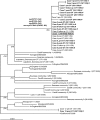Evidence of person-to-person transmission of oseltamivir-resistant pandemic influenza A(H1N1) 2009 virus in a hematology unit
- PMID: 21148492
- PMCID: PMC3086444
- DOI: 10.1093/infdis/jiq007
Evidence of person-to-person transmission of oseltamivir-resistant pandemic influenza A(H1N1) 2009 virus in a hematology unit
Abstract
We describe the first confirmed person-to-person transmission of oseltamivir-resistant pandemic influenza A(H1N1) 2009 virus that occurred in a hematology unit in the United Kingdom. Eleven cases of (H1N1) 2009 virus infection were identified, of which, ten were related as shown by sequence analysis of the hemagglutinin and neuraminidase genes. H275Y analysis demonstrated that 8 of 10 case patients had oseltamivir-resistant virus, with 4 of 8 case patients infected by direct transmission of resistant virus. Zanamivir should be considered as first-line therapy for influenza in patients with lymphopenic hematological conditions and uptake of influenza vaccination encouraged to further reduce the number of susceptible individuals.
Figures

Comment in
-
Emerging influenza antiviral resistance threats.J Infect Dis. 2011 Jan 1;203(1):6-10. doi: 10.1093/infdis/jiq012. J Infect Dis. 2011. PMID: 21148489 Free PMC article. No abstract available.
References
-
- Lackenby A, Hungnes O, Dudman SG, et al. Emergence of resistance to oseltamivir among influenza A(H1N1) viruses in Europe. Euro Surveill. 2008;13(5) - PubMed
-
- Update: influenza activity - United States, September 28, 2008–January 31, 2009. MMWR Morb Mortal Wkly Rep. 2009;58(5):115–119. - PubMed
-
- Oseltamivir-resistant 2009 pandemic influenza A(H1N1) virus infection in two summer campers receiving prophylaxis–North Carolina, 2009. MMWR Morb Mortal Wkly Rep. 2009;58(35):969–972. - PubMed
Publication types
MeSH terms
Substances
Grants and funding
LinkOut - more resources
Full Text Sources
Medical

